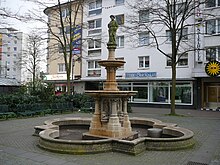Friedrich Küsthardt
Friedrich Küsthardt (born January 30, 1830 in Göttingen , † October 8, 1900 in Hildesheim ) was a German sculptor , craftsman and art writer.
Life

Küsthardt's parents were the "master tailor" ( shoemaker ) Conrad and Wilhelmine Friederike Justine, nee. Wielert. Growing up in poor conditions, he showed a talent for woodturning and locksmithing at an early age. According to his parents' wishes, he did an apprenticeship with a bookbinder until the master's brother threatened him with a knife out of envy of competition. In the confirmation age he prepared mammals and birds for Rudolf Wagner in the Physiological Institute and made his first experiences in plastic anatomy. He worked as a copper engraver for medical purposes and as a taxidermist .
In Hanover he turned to sculpture. In Frankfurt he worked under Eduard Schmidt von der Launitz on his Gutenberg monument . In 1857 he went to the Munich Academy and visited Rome in 1857/58.
In 1859 he settled in Hildesheim, where he held a teaching post at the newly founded building school, from 1889 to 1899 as a professor. He excelled in the art of tombs.
In Hamburg he created the tombs for the Wex (1888), Stahmer (1997/1998, Engel) and Hoyer (1900) families in the Ohlsdorf cemetery .
His sons were Helfried, Georg , Albert, Erwin and Friedrich the Elder. J. (1870-1905).
literature
- Küsthardt, Friedrich . In: Hans Vollmer (Hrsg.): General lexicon of fine artists from antiquity to the present . Founded by Ulrich Thieme and Felix Becker . tape 22 : Krügner – Leitch . EA Seemann, Leipzig 1928, p. 76 .
- W. Schmitz: Giessener contributions to art history. Volume 4, p. 64.
Web links
Individual evidence
- ↑ Barbara Leisner, Heiko KL Schulze, Ellen Thormann: The Hamburg main cemetery Ohlsdorf. History and tombs. Hans Christians publishing house, Hamburg 1990.
| personal data | |
|---|---|
| SURNAME | Küsthardt, Friedrich |
| ALTERNATIVE NAMES | Küsthardt, Friedrich Heinrich Nicolaus; Küsthardt, Friedrich the Elder Ä. |
| BRIEF DESCRIPTION | German sculptor, craftsman and art writer |
| DATE OF BIRTH | January 30, 1830 |
| PLACE OF BIRTH | Goettingen |
| DATE OF DEATH | October 8, 1900 |
| Place of death | Hildesheim |
